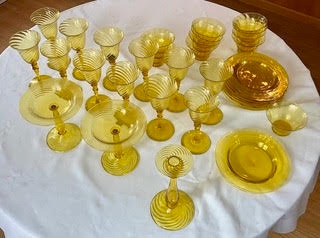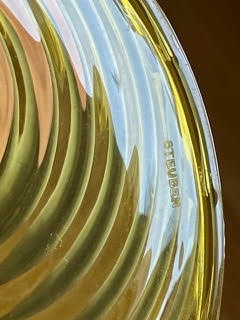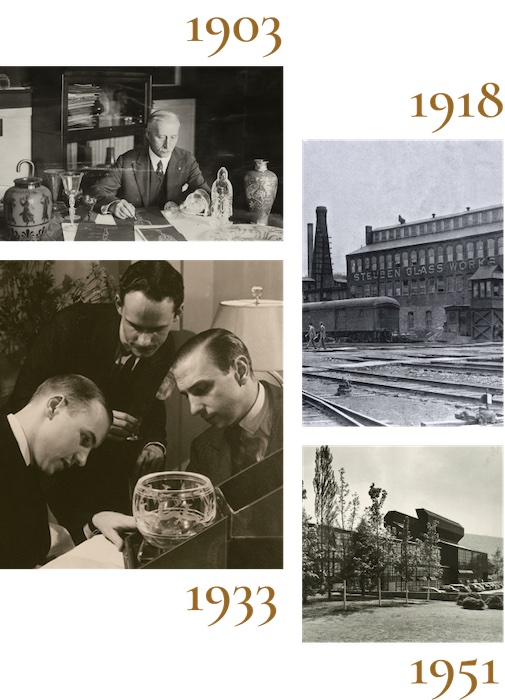Steuben Glass Set

BL sends me a fabulous yellow Steuben glass set, a barware service designed and created in the late 1920s by Frederick Carder (born England 1863, died Corning, NY, 1963) who was head of Steuben glass from 1903 – 1930. BL wonders about the color of his glassware set – and the history. The pattern is referred to as Twist Optic, and the color, named by Carder, is Bristol Yellow.
Carder was a fan of Chinese Ming Dynasty porcelain and admired the Imperial yellow glaze which held symbolic weight as representing power, royalty, prosperity, summer, and earth. Yellow glass is not common, because it is so unstable; it has fault lines. Frederick Carder, trained in glass chemistry, experimented with the composition of yellow glass as early as 1903 to create a stable yellow glass, and Carder sought a semi-opaque yellow hue. BL’s glassware set is not opaque; it is bright and clear – and stable, because it is not the semi-opaque glass that mimics Mandarin yellow porcelain. Carder reproduced the Mandarin Yellow of early Ming porcelain in glass, but only six pieces remain in existence at the Corning Museum of Glass, because that glass tends to break.

Yellow glass – created by using the chemical cadmium in an opaque vessel – is problematic: the vessel can develop ‘glass sickness,’ a problem that causes moisture on the glass surface because the glass has not properly annealed. The process of annealing is a gradual cooling of very hot glass after it is blown to prevent the internal stresses from the chemical instabilities inherent in the glass-making process.
Carder was such an important designer and inventor of new colors and shapes for glass that we have the Carder Steuben Glass Association, a group of collectors who study Carder’s designs from the period 1903-1932. Carder grew up in a pottery-making family in Staffordshire, England, and left school at 14 to work in at the kiln, but went back to school at night to study chemistry. He became fascinated by the process of making glass when he visited the glass maker responsible for perfectly reproducing the Roman vase known as the Portland vase. English glassmaker John Northwood had painstakingly reproduced the ancient cameo glass vase in the original medium, taking three years to complete it; in the process reviving the cameo glass art form in England. Carder would later apprentice with Northwood. Carder moved to Steuben Glass in Corning, New York in 1903 at the invitation of owner Thomas G Hawkes. When, in 1932, Steuben decided to make colorless glass, Carder left Steuben to become design director at Corning Glass. There he oversaw the creation of the cast panel for the Rockefeller Center; a four-ton molded glass panel. Created by Carder at Corning in 1935, the panel’s motif glorified the worker, and was the world’s largest sculptural glass panel and the chief decoration of the main entrance, called the Palazzo d’Italia. In his 80s Carder designed glass sculptures, and was still creating glass until he retired at 96. Carder is known for his creations in the styles of Art Nouveau and Art Deco. BL’ s barware set is in the Art Deco style: I can see Noël Coward sipping a cocktail from one of these vessels, wearing a cutaway tuxedo, white tie, and collar in the mid 1930s.

As a 10-year-old, I remember being shown the Corning Museum of Glass and the Frederick Carder Gallery: My parents rented a cottage in upstate New York, and my dad bought a tiny bud vase for my mom during that trip to that great museum, and had the vase engraved with a loving message. I will never forget the visit. We are lucky that Frederick Carder liked to golf, because one of his golfing buddies was a wealthy Corning area businessman who purchased many of Frederick’s pieces: By the 1940s, golf buddy Robert F. Rockwell had amassed a large enough Carder Collection that he founded the Rockwell Museum at the Carder Gallery at the Corning Museum of Glass.
Today Carder’s works are in that museum, but also in the Chrysler Museum of Art, and the Detroit Institute of Arts. Frederick Carder and Thomas G. Hawkes co-founded the Steuben Glass Works in Corning in 1903. Carder ran the company, producing iconic designs and colors, till 1932. In 1918 Corning Glass purchased Steuben but kept Frederick on as manager.
During the 82 years he worked with glass, Carder produced dazzling works that have influenced modern design. BL’s set is one of those. That set, at 72 pieces, could be worth as much as $15,000 to the right buyer. A good place to sell would be Los Angeles Modern Auctions.







You must be logged in to post a comment.